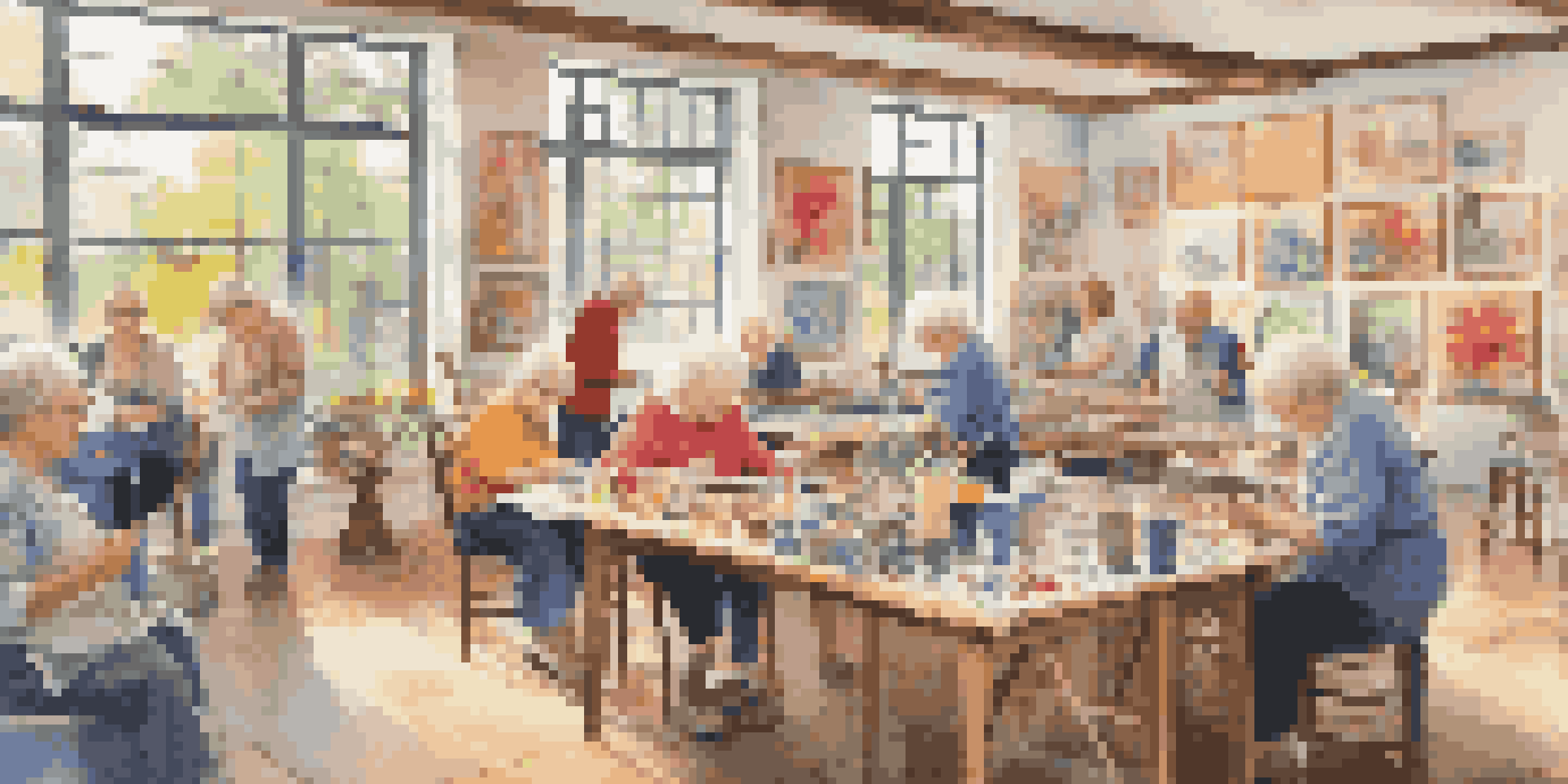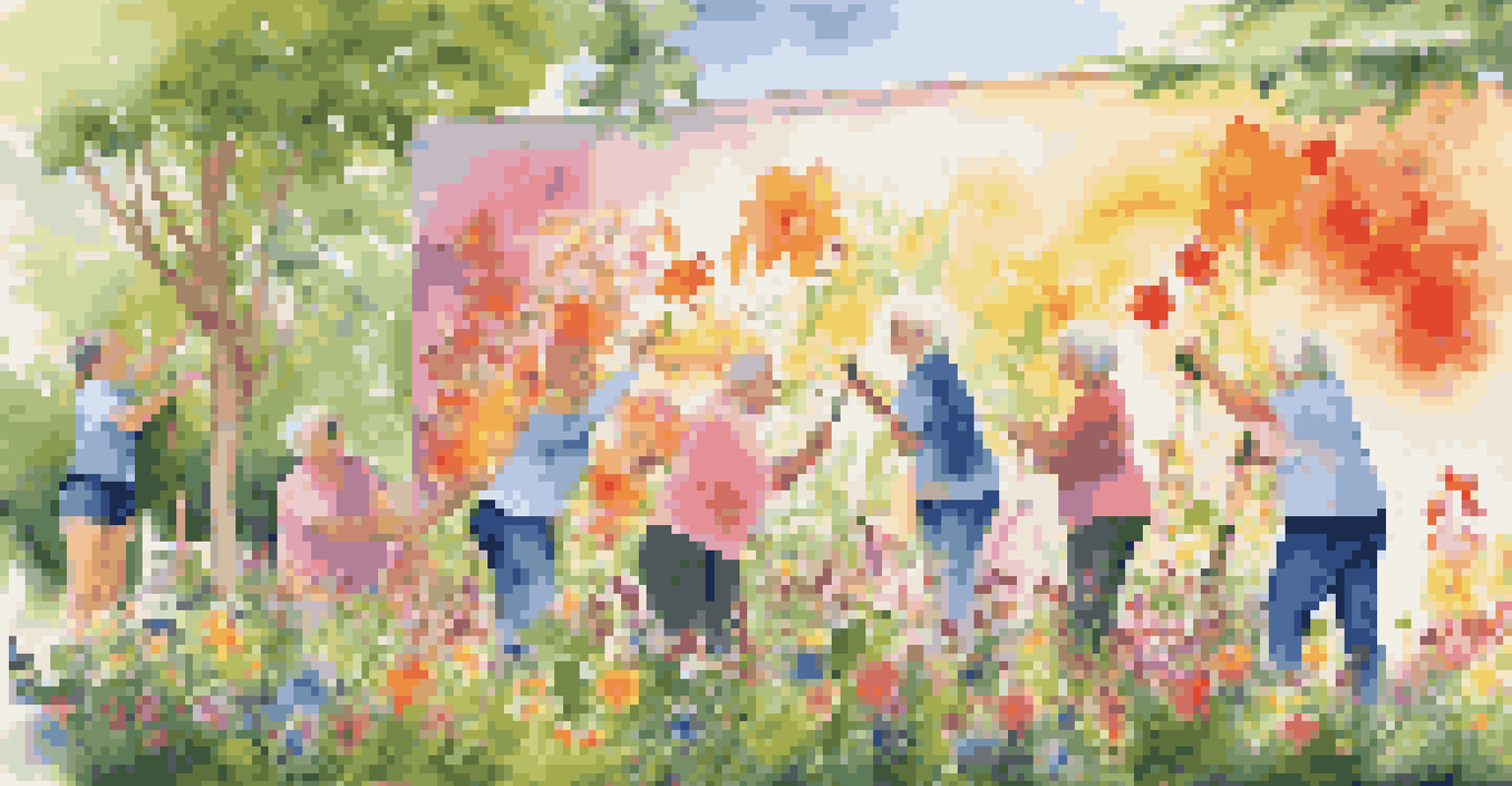Exploring the Role of Art in Senior Community Centers

Understanding the Importance of Art for Seniors
Art plays a vital role in enhancing the quality of life for seniors. It provides a creative outlet that can improve mental well-being and reduce feelings of isolation. Engaging in artistic activities can also stimulate cognitive function, keeping the mind active and engaged.
Art enables us to find ourselves and lose ourselves at the same time.
For many seniors, expressing themselves through art becomes a form of therapy. It allows them to share their experiences and emotions in ways that words sometimes can't capture. This form of expression not only fosters personal growth but also builds confidence and self-esteem.
Moreover, art can serve as a bridge to connect seniors with their community. Participating in group art activities fosters social interaction, creating a sense of belonging and camaraderie that is crucial for emotional health.
Types of Art Activities Available in Senior Centers
Senior community centers offer a diverse range of art activities, from painting and pottery to crafts and music. These programs are designed to cater to various interests and skill levels, ensuring everyone can find something they enjoy. For example, a painting class might encourage seniors to explore their creativity while learning new techniques.

Additionally, some centers host workshops that introduce seniors to digital art or photography, expanding their horizons and incorporating modern technology. This not only enhances their artistic repertoire but also helps them stay connected with family and friends through sharing their creations online.
Art Enhances Seniors' Well-Being
Engaging in artistic activities improves mental health, reduces feelings of isolation, and fosters personal growth among seniors.
Music and drama programs are also prevalent, allowing seniors to express themselves through performance. Participating in a theater group or singing in a choir can be incredibly rewarding, offering both a creative outlet and a fun way to socialize.
Art as a Therapeutic Tool for Seniors
Art therapy has gained recognition as an effective therapeutic practice for seniors. It provides a non-verbal means of communication, especially for those who may struggle to articulate their feelings. This is particularly beneficial for individuals dealing with memory loss or other cognitive challenges.
The arts are not a luxury; they are a necessity, an essential part of a holistic education for all ages.
Research has shown that engaging in artistic activities can lead to significant improvements in mental health, reducing symptoms of anxiety and depression. The process of creating art can be meditative, allowing seniors to focus on the moment and find joy in the act itself.
Furthermore, art therapy sessions often incorporate elements of reminiscence, helping seniors reconnect with their past. This can be a powerful way to evoke memories and spark conversations, aiding in cognitive function and strengthening emotional bonds with others.
Fostering Community through Collaborative Art Projects
Collaborative art projects are an excellent way to foster community spirit in senior centers. These projects encourage teamwork and creativity, allowing participants to contribute their unique perspectives and skills. Whether it’s a mural, a community quilt, or a group sculpture, the end result is a representation of the collective effort.
Working together on a shared goal helps build relationships among participants. It instills a sense of pride and accomplishment, as seniors witness their contributions come to life. These projects can also attract attention from the wider community, showcasing the talents and creativity of seniors.
Community Building Through Art
Collaborative art projects create social connections and foster community spirit, allowing seniors to share their unique perspectives.
Moreover, collaborative art initiatives often involve local artists or schools, bridging generations and creating opportunities for mentorship. This interaction enriches the artistic experience, allowing seniors to share their wisdom while learning from younger generations.
Art as a Medium for Storytelling and Connection
Art has a unique way of telling stories, making it a powerful tool for connection among seniors. Through various forms of artistic expression, individuals can share their life experiences and personal histories. This storytelling aspect of art can foster deeper understanding and empathy among peers.
For instance, a senior might create a painting that represents a significant moment in their life, sparking discussions with others who may relate to similar experiences. This not only reinforces social bonds but also validates their stories, making seniors feel valued and heard.
Additionally, art projects that focus on cultural heritage can help seniors connect with their roots. This exploration of identity through creativity can be incredibly enriching, allowing individuals to celebrate their backgrounds while sharing their stories with others.
The Role of Art in Cognitive Engagement for Seniors
Engaging in art stimulates various cognitive functions, which is especially important for seniors. Activities like drawing, painting, or crafting require concentration, problem-solving, and creative thinking. These cognitive challenges can help keep the brain agile, reducing the risk of cognitive decline.
For seniors experiencing memory loss, art can serve as a cognitive anchor. Familiar artistic activities can trigger memories and associations, providing a sense of comfort. This engagement not only enhances cognitive skills but also promotes a sense of accomplishment.
Art as a Cognitive Engagement Tool
Participating in art stimulates cognitive functions, helping seniors maintain mental agility and providing a sense of accomplishment.
Furthermore, art encourages continuous learning. Seniors can explore new mediums and techniques, keeping their creative juices flowing. This not only adds to their skills but also adds excitement and interest to their daily routines.
Conclusion: Embracing Art in Senior Community Centers
The role of art in senior community centers is multifaceted, enriching lives in numerous ways. It promotes mental health, fosters social connections, and enhances cognitive engagement, creating a holistic approach to well-being. As we continue to recognize the value of art, it is essential to support and expand these programs.
Encouraging more seniors to participate in artistic activities can lead to vibrant, engaged communities. By embracing art, we enable seniors to express themselves, share their stories, and connect with others, fostering a sense of belonging.

In conclusion, let’s champion the inclusion of art in senior community centers, ensuring that every senior has the opportunity to explore their creativity and enjoy the myriad benefits it brings.